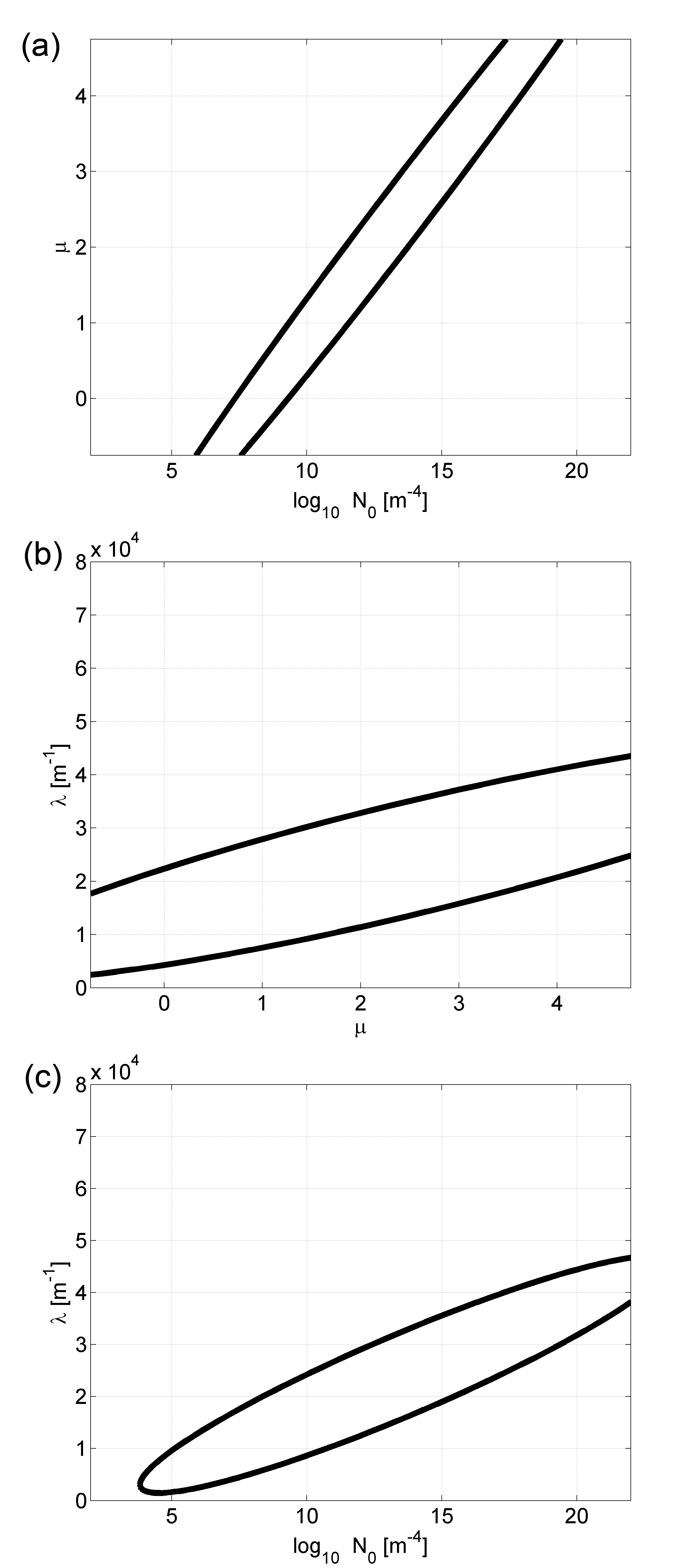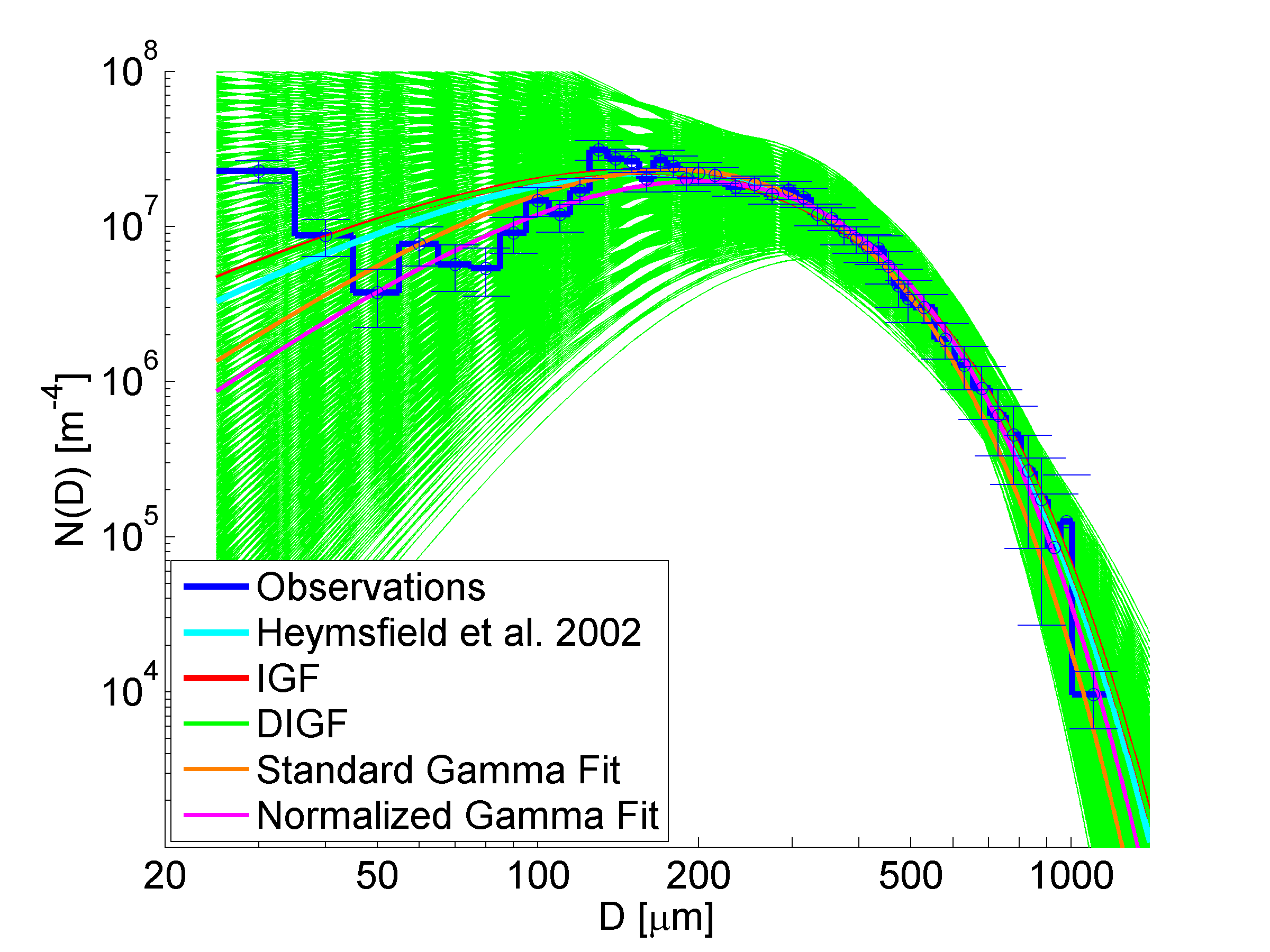Characterizing uncertainties in ice particle size distributions
Submitter:
McFarquhar, Greg — University of Oklahoma
Area of research:
Cloud Distributions/Characterizations
Journal Reference:
Science
In many parameterization schemes for numerical models or remote sensing retrievals, particle size distributions (SDs) are represented by gamma functions. Empirical relations, determined from in-situ measurements of SDs, are sometimes needed to determine how the parameters of the gamma function (slope lambda, intercept N0 and shape factor mu) depend on environmental conditions such as temperature, vertical velocity or total cloud water content. The manner in which such gamma parameters are characterized can have substantial influences on simulated or retrieved cloud properties. Although many prior studies have performed fits to measured SDs using data obtained in many different conditions, few studies have sought to characterize the uncertainties in the fit parameters or accounted for the fact that measured SDs only cover a limited range of particle sizes rather than covering the range 0 to infinity assumed in model schemes. In this study, a new Incomplete Gamma Fitting (IGF) technique developed at the University of Illinois is applied to data collected in Arctic cirrus during the DOE ARM Indirect and Semi-Direct Aerosol Campaign (ISDAC) and in hurricanes during the NASA African Monsoon Multidisciplinary Analyses (NAMMA) campaign in order to represent the gamma fit parameters as a volume of equally realizable solutions in N0-lambda-mu phase space.
Impact
Different fitting algorithms were applied to the data collected during ISDAC and NAMMA. Although the N0, lambda and mu obtained to represent a size distribution differed according to the choice of algorithm, the main control of the parameters was the tolerance permitted within an individual fitting routine, which was determined by the statistical uncertainty in the measured SD. This means that a three-dimensional volume in N0-lambda-mu phase space is required to represent a single SD. Figure 1 shows projections of this volume of equally realizable solutions in two-dimensional cross sections of the fit parameters for a single SD measured during ISDAC. The IGF determines this volume by minimizing the chi-squared difference between the measured and derived moments of the SD, with the variance on the fit parameters controlled by the uncertainty in the measured SD and on how well a gamma distribution matches the SD. The parameters within the volume of equally realizable solutions can vary substantially, with N0 in particular varying by several orders of magnitude. However, Figure 2 shows that the SDs determined from N0/lambda/mu values within this ellipse all provide reasonable representation of the measured SD, with the scatter of the SDs giving an estimate of the uncertainty in the derived product. Further, the range of calculated process rates, such as those determined in model parameterization schemes, determined by randomly selecting parameters from the volume of equally realizable solutions is much less, on the order of 20%, when the co-dependence of gamma parameters is properly accounted for.
A method to characterize a family of SDs in N0-lambda-my phase space is also developed by determining a single ellipsoid that best encompasses a fraction of the single ellipsoids that are generated for all the SDs within the family. The large range of variability of parameters within these ellipsoids suggests that the variability in fit parameters observed in past studies may be at least partly caused by the variability in how each SD is characterized, rather than by variability in the SDs themselves. By generating such ellipsoids for ranges of environmental conditions, it will be possible to ascertain how fit parameters, their uncertainties, and their correlations, vary with environmental conditions.
Summary
The method of developing volumes of equally realizable solutions in N0-lambda-mu phase space for characterizing gamma fits to observed SDs has immediate applications for the development of model parameterization schemes. Current schemes assume a single relationship for fit parameters in terms of environmental parameters, which has a big impact on microphysical process rates, which in turn affects latent heat release and the dynamics. The mutual dependence of gamma parameters is accounted for in this new approach because the ellipsoid of equally realizable solutions is mathematically characterized by the principal axis vectors and the lengths of those axes, derived from the covariance of the fit matrix. The range of fit parameters can thus be easily incorporated into a stochastic framework, where random values are selected from the ellipsoid of possible solutions to determine how uncertainties in microphysical parameterizations cascade to uncertainties in predictions of modeled parameters such as ice water content. Thus, it is imperative future studies determine how these volumes of equally realizable solutions vary with environmental conditions for observations obtained under a wide range of conditions in many different locations.



